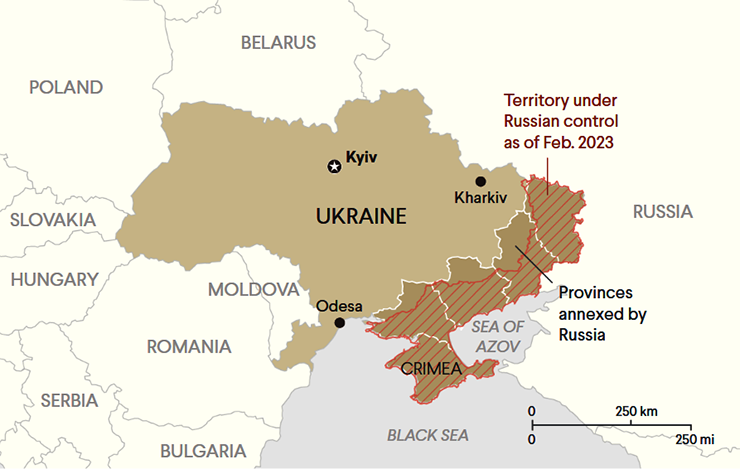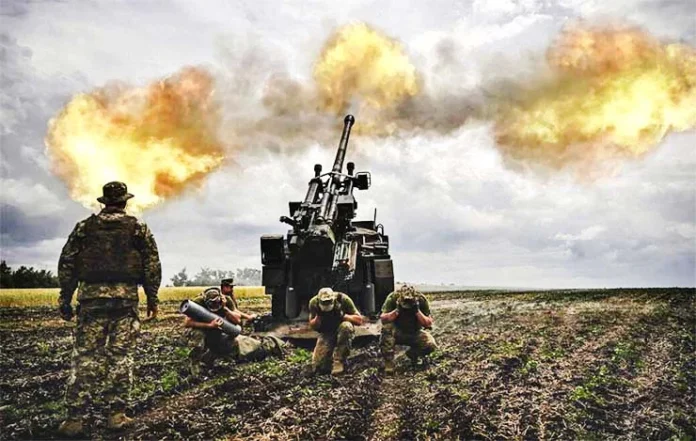Russia initiated a “special military operation” against Ukraine in February 2022, citing multiple reasons to justify its aggression. While the longstanding disputes over the expansion of the North Atlantic Treaty Organization (NATO) and the post–Cold War security architecture in Europe have gained attention, a more fundamental issue arises—the legitimacy of Ukrainian identity and statehood itself. But Russian President Vladimir Putin’s ideology emphasises deep-seated unity among the Eastern Slavs (Russians, Ukrainians, and Belarusians) with origins traced to the medieval Kyivan Rus commonwealth. The overall thrust is that Russia, Ukraine, and Belarus should share a political destiny today and in the future, claiming that Ukrainian and Belarusian identities are products of foreign manipulation, part of an “anti-Russia project” by the West.
Escalation and Historical Ties
The Russia-Ukraine War marked a dramatic escalation in an eight-year struggle that began with Russia’s annexation of Crimea in 2014. A year into the conflict, many analysts deemed it a major strategic error by Putin. The deep cultural, economic, political, and historical ties between Russia and Ukraine are significant. Ukraine played a vital role in the Soviet Union during the Cold War, being the second-most-populous and powerful of the fifteen Soviet republics. Home to much of the Soviet Union’s agricultural production, defence industries, military, including the Black Sea Fleet and part of the nuclear arsenal, Ukraine’s decision to break ties with the Union in 1991 hastened the Soviet Union’s disintegration.
Over the past three decades, Ukraine has sought to forge its own path as a sovereign state, aspiring to align with Western institutions such as the European Union (EU) and NATO. However, internal divisions regarding integration with Europe have been a persistent challenge for Kyiv.
A brief historical perspective on the Russia-Ukraine War reveals Putin’s claim that Russians, Ukrainians, and Belarusians are descendants of Ancient Rus, the largest state in Europe. The vast territory, from Ladoga and Novgorod to Kyiv and Chernigov, was bound by Old Russian language, economic ties, and the rule of the Rurik dynasty after the baptism of Rus—anchored in the Orthodox faith. Kyiv held a dominant position since the late 9th century. The term “Ukraine” historically referred to the Old Russian word “Okraina” (periphery), indicating border territories. Originally, “Ukrainian” referred to frontier guards protecting external borders.
Ukraine’s Path to Independence and Challenges Post-1991
Ukraine declared independence from the Soviet Union in 1991, emerging after seven decades of totalitarianism and navigating the aftermath of the civil war in the Bolshevik revolution, the 1930s famine, the harsh Nazi occupation, the Second World War holocaust, and political purges and stagnation. The countries of the former Soviet Union declared their independence nearly three decades ago. The Soviet Union, a Russian-dominated political construct, exercised control over the Ukrainian communist party, effectively remote-controlling it from Moscow. Political and cultural elites gravitated toward Moscow, perpetuating a relationship that originated in the pre-revolutionary era of Tsarist Russia, where Ukraine was exploited for the benefit of the ruling Russian class.
The primary catalyst for the crisis lies in Russia’s geostrategic interest in Ukraine. Russia grapples with financial crises and perceives Western interference in crucial territorial security areas, especially as it remains wary of NATO and EU encirclement. President Putin seeks to extend influence and establish a secure buffer zone
Owing to this historical baggage, Ukraine, in its newfound independence, lacked the statecraft traditions essential for constructing a new, independent state. Despite proclaiming independence in 1991, Ukraine’s historical ties with Russia persisted in energy, trade, and culture. The Ukrainian declaration, validated by a majority referendum in August 1991, marked a peaceful transition to independence, with Leonid Kravchuk elected as its first president. The 1994 Budapest memorandum aimed to decommission weapons and provided security assurances from the US, Russia, the United Kingdom, and France to guarantee Ukrainian territorial integrity.
Russian Aspirations and Ukrainian Dependence
Following independence, the Ukrainian economy grappled with challenges such as shortages, blackouts, inflation, and emigration. From 2004 to 2007, economic prosperity increased alongside a desire for greater democracy and human rights. Russian aspirations to control Ukraine’s periphery trace back to 2000, setting the stage for the contemporary conflict. President Putin’s strategy evolved from soft coercion to assertive and aggressive measures, with the Orange Revolution in 2004 prompting a reconsideration of tactics. Despite this, Russia maintained influence in key sectors, and Ukraine’s dependence on Russian gas persisted.
A gas deal in 2008 committed Ukraine to being the largest buyer of Russian gas at an above-market price. The Russian navy’s Black Sea fleet continued to be based in Crimea, secured by a 2010 deal ensuring its long-term presence. Neutrality, insisted upon by Russia in Ukraine’s Constitution, prevented NATO membership. However, public demand for closer integration with the EU intensified, fuelling increased hostility from Russia against the EU and NATO, aimed at preventing a democratic Ukraine from joining the EU market.
Russia’s Geostrategic Interest and Ethnic Dynamics
The primary catalyst for the crisis lies in Russia’s geostrategic interest in Ukraine. Russia grapples with financial crises and perceives Western interference in crucial territorial security areas, especially as it remains wary of NATO and EU encirclement. President Putin seeks to extend influence and establish a secure buffer zone. Additionally, Russia’s desire to access Ukraine’s abundant resources, including oil, gas, and crops, contributes significantly to the crisis. The West’s influence in the region, manifested through NATO and the EU, poses a threat to Russia’s interests, as it views Ukraine as essential for geostrategic depth.
Ethnic interests are another factor, driven by the large ethnic Russian population in Ukraine practicing Orthodox Russian religion, fostering religious, economic, and cultural homogeneity. Since the Soviet Union’s disintegration, the West’s focus on reforms, including democracy, capitalism, and human rights preservation, aimed at keeping Russia at bay and solidifying NATO’s influence in the region. President Putin, wary of encirclement, vehemently opposes Western advancement.
Local issues, both ethnic and economic, further escalate the conflict. While Ukraine perceives economic benefits in its relations with the West, Russia aims to maintain its sphere of influence. The Ukrainian social structure, despite comprising various ethnic minorities, becomes a pretext for Russia to support ethnic Russians in Southeast Ukraine, such as the Donbas and Luhansk regions, providing military and economic assistance to these minority groups. Anti-Russian groups in Ukraine seek agreements with the West for economic development and to counter Russia’s ethnic interests.
The initiation of the Russian invasion of Ukraine finds roots in historical context and geopolitical factors. The international system’s structural feature, determining power distribution among states, involves the permanent geographic positions of major power centres like Russia, China, and the US. Historical factors, nationalistic sentiment, narratives, and Russia’s desire to reclaim perceived territories contribute significantly to its ongoing military action in Ukraine. Geopolitical positioning shapes international politics, and these factors collectively triggered Russia’s invasion of Ukraine.

President Putin has openly criticized the dissolution of the Soviet Union as a catastrophe, asserting that his two-decades-long rule has focused on rebuilding the Russian powerbase and sphere of influence over former Soviet states. The Russian leadership is driven by an inherent desire to maintain control over Ukraine, Belarus, Georgia, and other states geographically positioned as natural buffer zones against Europe (Figure 1).
While Ukraine perceives economic benefits in its relations with the West, Russia aims to maintain its sphere of influence. The Ukrainian social structure, despite comprising various ethnic minorities, becomes a pretext for Russia to support ethnic Russians in Southeast Ukraine, such as the Donbas and Luhansk regions, providing military and economic assistance to these minority groups
A primary catalyst for the Russian invasion of Ukraine in February 2022 is Ukraine’s pursuit of NATO membership. Russia, viewing this as encroachment, has taken assertive actions to prevent the perceived westward expansion of NATO, especially the entry of former Warsaw Pact member states. Russia argues against NATO expansion on grounds that it violates a prior Alliance pledge not to spread eastward and accuses the West of actively seeking Ukraine’s NATO membership.
Europe’s Energy Dependency
The strained relationship between Russia and Ukraine is further complicated by Ukraine’s role as a crucial transit route for Russian natural gas exports to Europe. Despite the conflict, Russian gas continues to transit through Ukraine, albeit at a reduced rate of 35–40 million cubic meters per day (mcm/d) compared to pre-conflict levels. The Ukrainian gas transmission system connects with four EU member states: Poland, Slovakia, Hungary, Romania, and Moldova. From July 2022 to June 2023, six EU countries—Slovakia, Austria, Italy, Hungary, Slovenia, Croatia, and Moldova—continued to receive Russian gas through the Ukrainian transit corridor, highlighting the irony of oil and gas flowing through Ukrainian pipelines amid the conflict.
Before the 2022 conflict, Europe heavily relied on Russian gas, with nearly 40-45 percent of its imported gas and about a quarter of its oil reaching Europe through these pipelines. Despite Europe’s attempts to reduce dependence on Russian energy, the ongoing flow of oil and gas underscores the impact of the old system, contractual obligations, market dynamics, and political considerations.
References
- https://spa.ukma.edu.ua/en/analytics/anti-russia-what-is-putin-afraid-of/
- https://www.cfr.org/backgrounder/ukraine-conflict-crossroads-europe-and-russia
- http://www.en.kremlin.ru/events/president/news/66181.
- https://www.chathamhouse.org/2021/11/ukraine-russia-relations.
- https://afsa.org/did-nato-expansion-really-cause-putins-invasion.
- https://www.iir.cz/en/lies-provocations-or-myths-pretexts-nato-and-the-ukraine-crisis.
- https://www.energypolicy.columbia.edu/qa-russian-gas-transit-through-ukraine/





